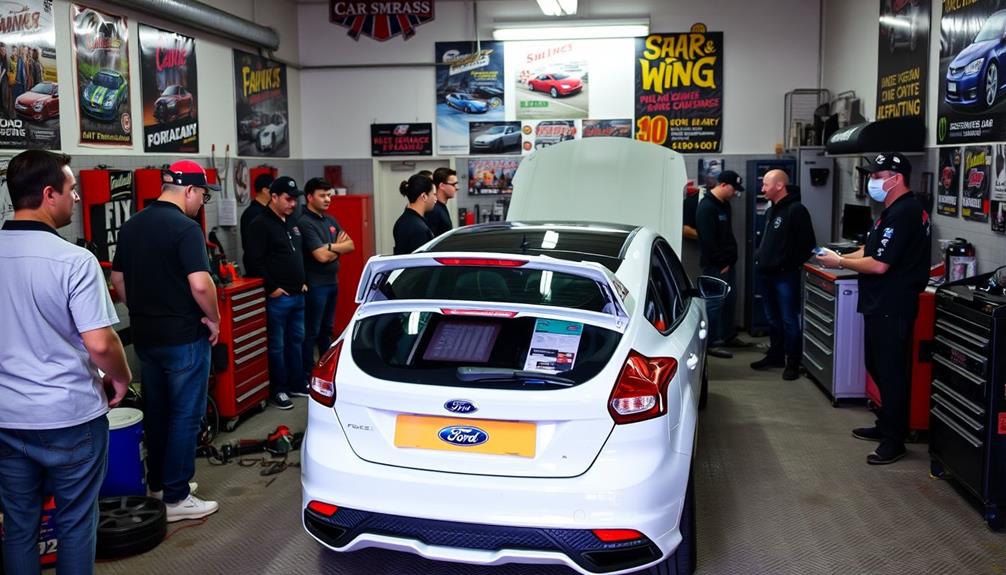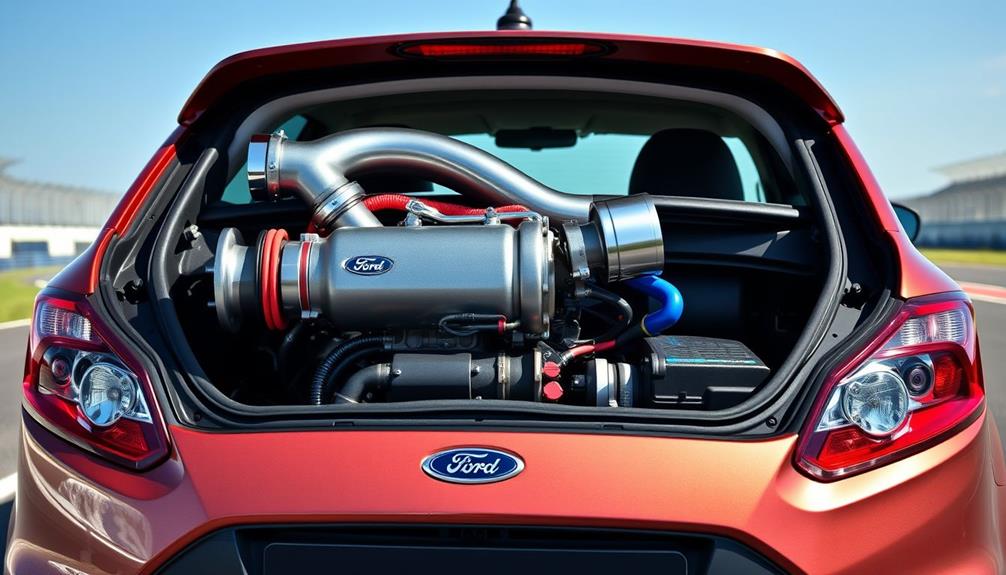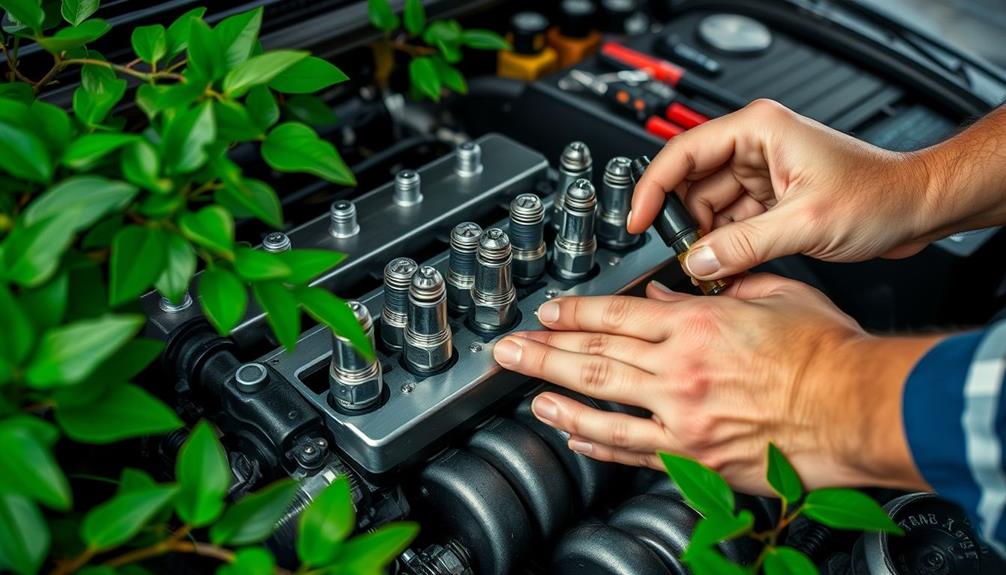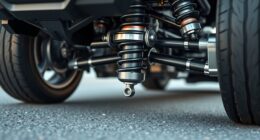Tuning your 2012 Ford Focus can greatly boost its performance. Start by upgrading your air intake with an RS Intake and a green filter to improve airflow. Consider installing a Ford 63MM throttle body for better throttle response. An Fswerks 4-1 header and Stealth Exhaust will enhance exhaust flow and sound. For peak gains, custom tuning with Focus Power Tune is essential after these modifications. Don't forget to monitor your performance metrics, and verify you're using high-quality fuel for the best results. There's plenty more to discover about maintaining and maximizing your hatchback's capabilities.
Key Takeaways
- Upgrade your air intake and exhaust systems with RS Intake and Fswerks headers for improved airflow and horsepower gains.
- Custom tune your vehicle using Focus Power Tune to optimize performance after modifications.
- Use premium fuel (91 octane or higher) to enhance engine performance and prevent knock.
- Regularly replace spark plugs, ideally every 20,000 miles, to maintain optimal engine efficiency and responsiveness.
- Engage with the Ford Focus community for insights, troubleshooting support, and to share modification experiences.
Performance Modifications Overview
When it comes to enhancing your 2012 Ford Focus, performance modifications can make a world of difference in how the car feels and drives. Key upgrades include improving the intake and exhaust systems, which can yield significant horsepower gains and enhance throttle response.
By installing a Ford 63MM throttle body and an RS Intake with a green filter, you'll notice better air intake, leading to improved engine performance and efficiency.
Additionally, aftermarket options like the Fswerks 4-1 header and Stealth Exhaust can elevate exhaust flow and sound, further boosting your car's overall performance metrics. These modifications not only enhance power but also contribute to a more enjoyable driving experience.
However, to release the full potential of these performance modifications, a custom tune is essential. Tuning your engine with a Focus Power Tune guarantees compatibility with your new parts and optimizes performance.
Combining these enhancements can lead to substantial improvements in your 0-60 mph times, making your Focus more responsive on the road. Embracing these performance modifications is the key to transforming your driving experience in your 2012 Ford Focus.
Essential Parts for Tuning

To get the most out of your tuning efforts for the 2012 Ford Focus, it's essential to focus on a few important parts that can greatly enhance performance. Upgrading these components can transform your hatchback into a more dynamic and responsive vehicle.
Here are four key parts to take into account:
- RS Intake with Green Filter: This upgrade boosts air intake efficiency, leading to better throttle response and overall performance.
- Ford 63MM Throttle Body: Installing this throttle body improves airflow, resulting in more responsive acceleration and increased horsepower potential.
- Fswerks 4-1 Headers: These headers enhance exhaust flow, allowing for greater power output, but sourcing them may be challenging.
- Fswerks Stealth Exhaust: Not only does this exhaust improve sound quality, but it also optimizes exhaust flow efficiency for better performance.
After making these modifications, utilizing a Focus Power Tune is essential. This tune guarantees your modified Ford Focus ST operates at its best, maximizing the performance gains you've achieved.
Measuring Performance Gains

How can you truly gauge the performance improvements after tuning your 2012 Ford Focus? The key lies in measuring specific metrics that reflect your car's enhanced capabilities.
Start by monitoring your 0-60 mph times and quarter-mile times—these figures provide tangible evidence of your performance gains. After modifications like intake and exhaust upgrades or a well-executed ECU remap, you might see horsepower increases ranging from 10-30%, with documented cases showing boosts from 147 bhp to over 211 bhp.
Using data logging tools can help you track essential parameters such as boost pressure, fuel trims, and timing advance. These metrics allow you to fine-tune your performance even further.
Regularly checking boost levels guarantees your modifications are delivering the intended results and helps maintain engine health.
Don't forget the importance of routine maintenance, like spark plug changes and oil quality checks, to sustain those performance gains.
Community Resources for Enthusiasts

A vibrant community of Ford Focus enthusiasts awaits you, ready to share valuable resources and insights. Engaging with fellow owners can greatly enhance your tuning journey. Here are some key features of this supportive environment:
- Focus Fanatics Forum: This all-encompassing platform is a treasure trove for discussions about modifications and performance upgrades.
- User-Built Threads: Immerse yourself in detailed insights from other members who've successfully navigated tuning challenges, learning from their experiences.
- Troubleshooting Support: Get advice on maintenance issues, as community members actively help each other tackle common Ford Focus problems.
- Classified Sections: Find or trade performance parts with ease, ensuring you access aftermarket upgrades at competitive prices.
Participating in these forums not only provides you with essential tips and tricks but also fosters a sense of camaraderie among enthusiasts.
By sharing knowledge and experiences, you'll become part of a community dedicated to optimizing the Ford Focus.
Installation Tips and Tricks

Engaging with fellow enthusiasts equips you with valuable insights, and when it comes to installation, having the right tips can make all the difference.
First, always confirm that the aftermarket parts you choose, like intakes or exhaust systems, are compatible with your specific 2012 Ford Focus model. This step is vital to avoid fitment issues and enhance performance gains.
Before you start, gather all necessary tools and parts. This preparation minimizes downtime and helps streamline the installation process.
When tackling complex modifications, such as turbo kits, consider seeking professional installation. Proper setup is important to prevent potential engine damage from incorrect installations.
Always refer to the manufacturer's instructions for any specific requirements or tools needed. These guidelines can help you navigate the installation smoothly and avoid common pitfalls.
After completing your modifications, monitor your vehicle's performance closely. Adjustments may be necessary for peak tuning and to address any issues that arise.
Fuel Quality Impact

Fuel quality plays an essential role in the performance of your 2012 Ford Focus. To truly maximize your hatchback's capabilities, consider the following factors:
- Use Premium Fuel: Opt for fuel with an octane rating of 91 or higher to prevent engine knock and guarantee smooth operation.
- Enhance with E85: Mixing in 1 gallon of E85 can elevate your effective octane rating to around 105, improving combustion efficiency.
- Consider Octane Boosters: Adding xylene, which has an octane rating of 116.5, can further enhance fuel quality, though it might increase your fuel costs.
- Consistency is Key: Regularly using premium fuel not only boosts performance but also contributes to your engine's longevity, especially after modifications.
Turbocharger Enhancements

When you contemplate turbocharger enhancements for your 2012 Ford Focus, you're opening the door to considerably improved performance. Upgrading from the stock turbo can yield substantial increases in power output, especially with larger turbos that excel at higher RPMs.
Just keep in mind that while they boost overall performance, you might notice a compromise in low-end response.
To fully capitalize on your turbo boost, installing a high-performance intercooler is vital. It helps manage ideal temperatures, preventing heat soak during sustained pulls, and ultimately enhances horsepower and torque.
Many users report gains of 30% or more in horsepower when they pair turbo upgrades with proper tuning and supporting modifications like exhaust systems and intakes.
Don't forget about fuel quality—using higher octane fuel (91 or above) is essential. It prevents engine knock and maximizes the benefits of your turbocharging setup.
Finally, think about custom tuning after your turbo installation. This optimizes engine performance, improves throttle response, and guarantees your Focus runs efficiently and reliably.
Spark Plug Maintenance

When it comes to spark plug maintenance for your 2012 Ford Focus, knowing the right type and replacement frequency is essential.
You'll want to take into account using NGK Iridium plugs for improved performance and replace them every 20,000 miles or so.
Let's also cover some installation tips to guarantee you get the best results from your maintenance efforts.
Recommended Spark Plug Types
Have you considered how vital spark plugs are for your 2012 Ford Focus's performance? The right spark plugs can greatly enhance your engine's efficiency and responsiveness.
Here are some reasons why choosing the proper spark plug matters:
- Superior Ignition Performance: NGK Iridium spark plugs provide excellent ignition, ensuring a smoother start and better throttle response.
- Longevity: These plugs can last up to 60,000 miles or more, reducing the frequency of replacements.
- Fuel Efficiency: Regularly changing spark plugs every 20,000 miles helps maintain ideal fuel efficiency, saving you money at the pump.
- Reduced Emissions: High-quality spark plugs like NGK Iridium contribute to better combustion, which can lower your vehicle's emissions.
It's essential to install your spark plugs correctly, too.
Make sure to verify and adjust the spark plug gaps according to the manufacturer's specifications. Incorrect gaps can hinder performance, negating the benefits of using NGK Iridium spark plugs.
Replacement Frequency Guidelines
To keep your 2012 Ford Focus running smoothly, it's vital to replace the spark plugs every 20,000 miles or less. Regularly changing your spark plugs guarantees peak engine performance and fuel efficiency.
If you use NGK Iridium spark plugs, you'll notice improved ignition reliability, which is significant for maintaining your vehicle's performance.
When spark plugs wear out, they can disrupt the air-fuel mixture, leading to engine misfires and various performance issues.
Installation Tips and Techniques
Maintaining your spark plugs is key to guaranteeing your 2012 Ford Focus performs at its best. Regular spark plug maintenance not only enhances engine efficiency but also improves throttle response and fuel economy.
Here are some essential tips for installation:
- Replacement Frequency: Change your spark plugs every 20,000 miles or less for ideal ignition performance.
- Choose Quality: Use NGK Iridium spark plugs, known for their durability and superior ignition characteristics.
- Proper Gapping: Always gap your spark plugs according to the manufacturer's specifications. This guarantees efficient combustion and prevents misfires.
- Torque Settings: Utilize a torque wrench when installing the plugs. This prevents over-tightening, which can damage the threads in the cylinder head.
Understanding ECU Limitations

When tuning your 2012 Ford Focus, it's vital to understand the limitations of its stock ECU. The factory ECU controls performance by adjusting timing, fueling, and boost according to torque requests, which can actually restrict power output. Without aftermarket mapping, you won't see any increase in peak output, even if you upgrade your intake or exhaust systems.
Environmental factors like temperature, elevation, and humidity can also affect your vehicle's performance consistency. That's why custom tuning is important; it can refine the torque targeting logic of the stock ECU, leading to better power and responsiveness from your modifications.
If you've made changes to your engine, consider disconnecting the battery to reset the ECU settings. This can help recalibrate the engine's performance, allowing it to adapt better to your recent upgrades.
Engaging With the Community

Connecting with fellow Ford Focus enthusiasts can really enhance your tuning journey.
By sharing your modification experiences and troubleshooting challenges, you'll gain valuable insights and support from the community.
Plus, you can discover performance upgrade recommendations that might just take your Focus to the next level.
Sharing Modification Experiences
Many enthusiasts find that engaging with communities like Focus Fanatics can greatly enhance their tuning experiences. By sharing your modification experiences, you can gain invaluable insights and tips from fellow Ford Focus owners.
Here's how you can benefit from active participation in these communities:
- Detailed Build Threads: Document your performance modification journey and learn from others' experiences.
- Tuning Discussions: Engage in conversations about tuning options like Cobb Accessport or custom tunes, helping you make informed decisions.
- Upgrade Insights: Share and receive feedback on upgrades, such as turbo kits or cold air intakes, fostering a culture of collaboration.
- Vendor Reviews: Discuss vendor services and product reliability, which can greatly influence your purchasing choices.
Troubleshooting and Support
Maneuvering through the complexities of tuning your 2012 Ford Focus can be intimidating, but engaging with the Focus Fanatics community makes it easier. By participating in forums, you can gain valuable insights and troubleshooting tips from experienced members who've successfully modified their vehicles.
Discussing specific performance upgrades allows you to identify potential issues and solutions shared by others, whether it's installation challenges or part compatibility.
Utilizing user-built threads is a great way to learn from the experiences of fellow enthusiasts. You can discover their successes and setbacks with various tuning modifications and engine upgrades, which can save you time and frustration.
Furthermore, the community often shares diagnostic tools and techniques to monitor your vehicle's performance post-tuning, ensuring that you're well-equipped to troubleshoot any emerging issues.
Don't forget to check out the classified sections within the forums, where you can find reliable sources for purchasing performance parts and upgrades.
Connecting with other enthusiasts not only enhances your knowledge but also provides a supportive network to help you navigate the complexities of your tuning journey.
Performance Upgrade Recommendations
Engaging actively with the Focus Fanatics community often leads to discovering the best performance upgrade recommendations for your 2012 Ford Focus.
Fellow enthusiasts share their experiences and insights, making it easier for you to enhance your ride. Here are some top upgrades to take into account:
- RS Intake with a Green Filter: This upgrade improves air intake, providing better airflow for increased horsepower.
- Fswerks 4-1 Header: Enhancing exhaust flow, this header can greatly boost your engine's performance.
- Focus Power Tune: After installing aftermarket parts, this tuning option optimizes engine performance, ensuring you get the most out of your upgrades.
- User-Built Threads: These valuable resources often detail successful modifications, helping you understand potential gains and challenges.
Frequently Asked Questions
How to Increase Horsepower on 2012 Ford Focus Se?
To increase horsepower on your 2012 Ford Focus SE, consider upgrading the intake system, installing a larger throttle body, adding headers and an exhaust system, and tuning the engine for peak performance. Don't forget better tires!
How Much Horsepower Does a 2012 Ford Focus SE Hatchback Have?
The 2012 Ford Focus SE Hatchback packs 143 horsepower at 6,100 RPM. With its responsive engine and versatile transmission options, you'll enjoy a blend of performance and efficiency, making it a great choice for compact car lovers.
Are Ford Focus Hatchbacks Fast?
You'd think a Ford Focus hatchback couldn't outrun a cheetah, but it can surprise you! With the right modifications, it's not just fast; it becomes a thrilling ride, leaving many cars in the dust.
What Is the Top Speed of the 2012 Ford Focus Hatchback?
The 2012 Ford Focus Hatchback can reach a top speed of about 120 mph. With performance modifications, you might exceed this limit, but factors like weight and aerodynamics will also influence your results.
Conclusion
Tuning your 2012 Ford Focus can seem challenging, but it's totally worth it for the performance boost. You might worry about the cost, but remember, even small modifications can lead to noticeable gains without breaking the bank. By focusing on essential parts and engaging with fellow enthusiasts, you'll not only enhance your hatchback but also enjoy the camaraderie of the community. So, jump in, get your hands dirty, and watch your Focus transform into a true performance machine! Tuning your 2012 Ford Focus can provide you with a fun and engaging project to work on in your spare time. But don’t stop there – consider tuning your Toyota Hilux as well! With the right modifications, you can unlock even more power and potential from your truck. Whether you’re a weekend warrior or a daily driver, tuning your Toyota Hilux can take your driving experience to a whole new level.









